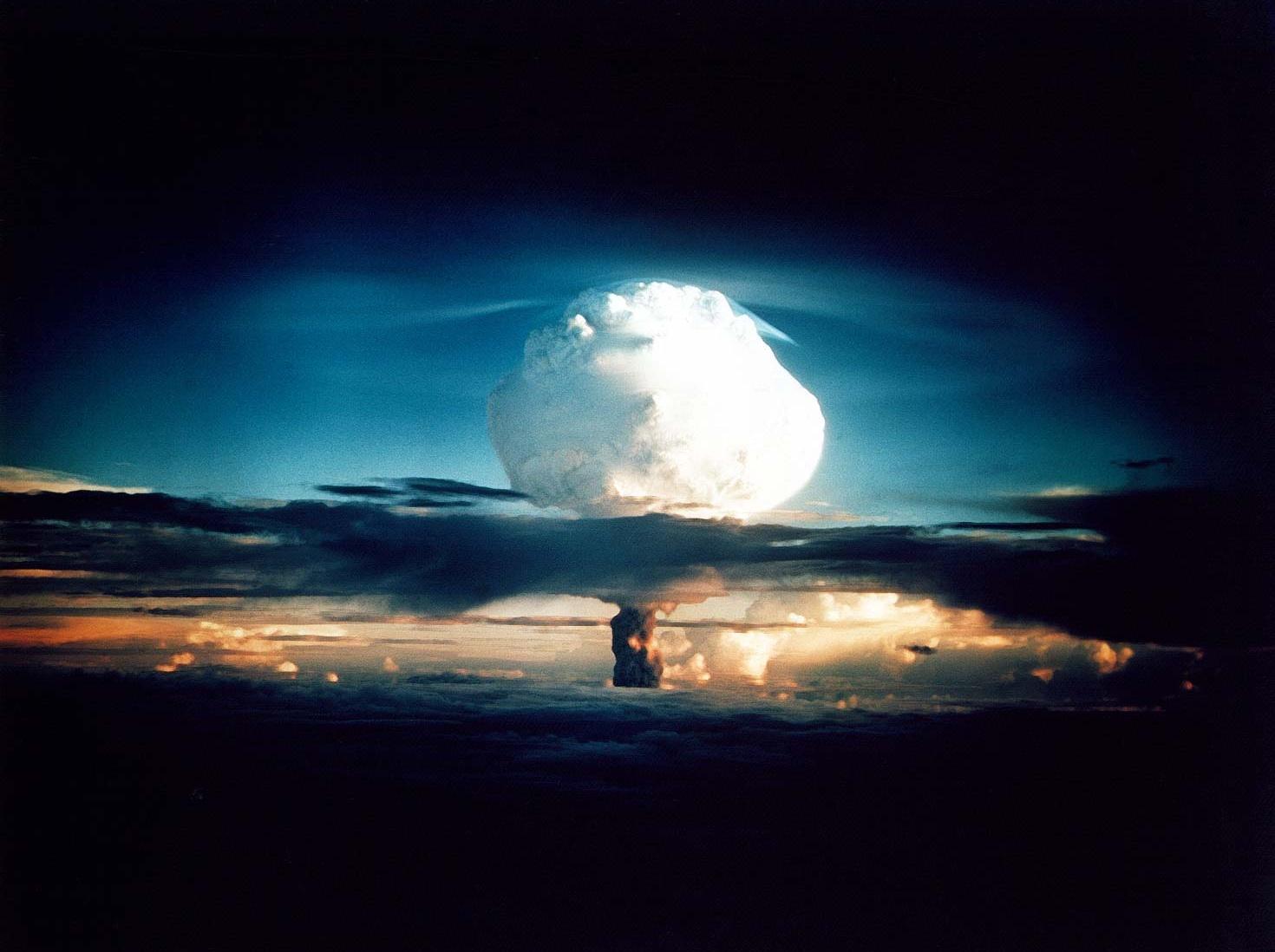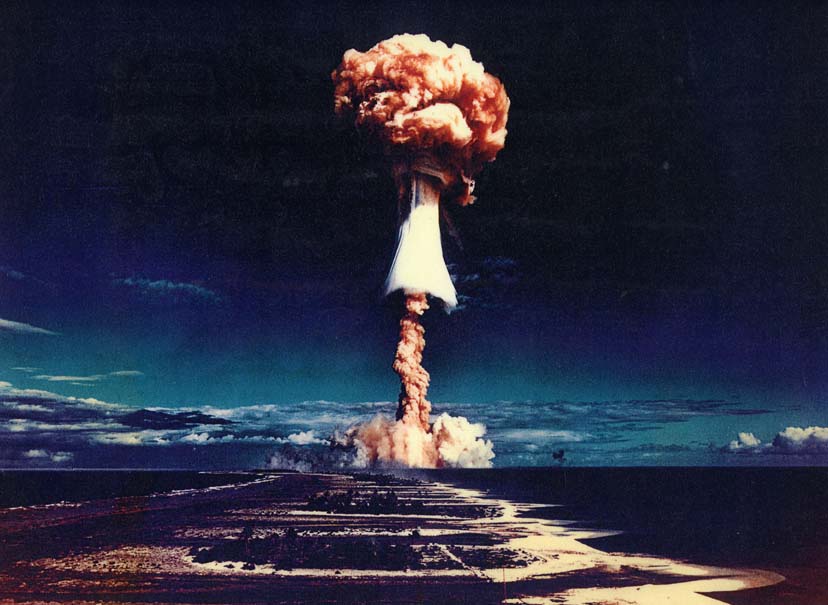
Operation Ivy, hydrogen bomb “Mike” (yield 10.4 Mt) on Enewetak Atoll, 1 November 1952. Credits: National Nuclear Security Administration / Nevada Site Office.
In our deeply iconographic world, images come to define entire eras, encapsulating them in the manner of a sign. In this sea of visuals we all find ourselves engulfed into, few are perhaps as instantaneously recognizable as that of the mushroom cloud.
Peter B. Hales, in “The Atomic Sublime” (1991), has showcased how this strikingly and strangely shaped cloud has been encultured to aesthetically signify awe rather than horror. From a regime of relative secrecy, indeed, the American use of images and movies of atomic tests became the primary vehicle for military propaganda during the Cold War, particularly as those were shot and presented through the register of the sublime.
The geographical position of these tests, moreover, chosen for particular purposes. In Oceania, where many American, and a majority of French, and British bombs were tested, the jarring juxtaposition of two icons — the paradisiac islands and the mushroom cloud — “begot a terrible beauty,” Hales writes, for the “natural Eden of the South Pacific could and would ‘scrub’ the bomb of its hellishness, would redeem it, would purify it” (Hales 19-20). In a similar manner, the desert, once evoking the hellish final frontier of American settler expansion, sublimated to the bomb. This display of might was thus turned into a spectacle: the world was called to witness the bomb and its destructive beauty — Dionysos and Apollo.
This spectatorship dimension, as Jennifer Fay contends in Inhospitable World: Cinema in the Time of the Anthropocene (2018), transformed nuclear tests into aesthetic and anesthetic commodities, thereby by separating the event proper from the image itself through the production of dozens of Hollywood movies distributed on television.1 “The theatricality of the test and the diegetic effect of its supposedly managed environment are part and parcel of the testing regime, and not only for the sake of shaping public opinion and stoking the hope of American endurance” she writes. “In the regime of nuclear testing and filming, cinema turns the unpredictability and unique destruction of each test into a controlled, contained, and, above all, striking and repeatable image” whose effects come to anesthetize the West to the horrors of such devices and their effects on people and the environment (63).
Atomic bombs, however, are neither commodities, nor “normal” devices by any stretch of the word: beyond their destructive capabilities far surpassing any other kinds of military devices, their radioactive effects change the fabric of atoms, altering life at the level of genetics long after the “event” has passed. As Kai Erikson put it in his inquiry into nuclear trauma “The day the world turned red” (2011), the familiar structures of narrative recede in the wake of radioactivity. While natural disasters often follow a rule of plot with beginnings, middles, and ends, invisible radioactive contaminants released by the bombs “are absorbed into the landscape, into the tissues of the body, and, worst of all, into the genetic material of the survivors,” becoming a “constant of life.” In that sense, the radioactive catastrophe that follows the bombs lingers generationally — “The book of accounts is never closed” (41).
Whereas atomic bombs were predominantly detonated in areas remote from densely populated Western centers, framed through the language of “isolation” as Elizabeth DeLoughrey has demonstrated (2012), most often on Indigenous territories deemed worthless and whose inhabitants were involuntarily (and unknowingly) enlisted as test subjects, their frequency, however, ultimately reached global effects.
Between 1945 and 2017, a total of 2,056 nuclear bombs were tested around the world. During peak activity, from 1945 to roughly 1988, it is estimated that a nuclear bomb was set off, on average, every 9.6 days (Zalasiewicz in Fay 64). The contaminants released over a period of forty-odd years, dispersed through atmospheric currents, have seeped into our bones, passed on from generation to generation. As DeLoughrey puts it:
“[t]he lie of isolation has indeed been a dangerous game […]. Due to these thermonuclear weapons, the entire planet is permeated with militarized radiation. […] Radioactive elements produced by these weapons were spread through the atmosphere, deposited into water supplies and soils, absorbed by plants and thus into the bone tissue of humans all over the globe. The body of every human on the planet now contains strontium, a man-made byproduct of nuclear detonations and forensic scientists use the traces of militarized radioactive carbon in our teeth to date human remains (as before or after the 1954 Bravo shot). At very conservative estimates, these nuclear weapons tests have produced 400,000 cancer deaths worldwide.”
DeLoughrey 2012, 179
While human DNA is now overwritten by the bombs, few places are more contaminated with radioactive materials than Oceania, where between 1946 and 1996, the U.S., the U.K., and France have tested a total of 318 nuclear devices in the Marshall Islands, French occupied Polynesia/Mā’ohi Nui, Kiribati, Australia, the U.S. territory of Johnston/Kalama Atoll, and Amchitka Island, Alaska.
The damage is extensive: beside entire sections of atolls vaporized under the mushroom cloud, some loci have been so irradiated that they can no longer be inhabited: Bikini, Enewetak, Moruroa, Fangataufa, and many others, are all places that have been sacrificed on the alter of atomic power. In French occupied Polynesia/Mā’ohi Nui and in the Marshall Islands especially, radio-induced diseases continue to claim victims while compensations and State accountability lag behind.
Tomas Statius and Sébastien Philippe have demonstrated in their groundbreaking research Toxique: Enquête sur les essais nucléaires français en Polynésie (2021) and its companion website Moruroa Files, that the vast majority of French occupied Polynesia, more notably its most populous island, Tahiti, has been exposed to a high dosage of radiation during the 30 years of French atomic testing (1966-1996) in the region. In July 1974, for instance, the fallout from one of the last French atmospheric tests, “Centaure,” was an utter catastrophe: pushed by North-West winds toward the most inhabited places of Mā’ohi Nui, the radioactive cloud made its way to Tahiti and the Society Islands 2 days after the explosion. A spell of rain falling on the region, moreover, further helped the contamination of up to 110,000 people (Statius and Philippe 133-134). This one summer 1974 alone, the entire population of Tahiti was exposed to doses of at least 1 mSv, reaching up to 50 mSv, that is, 50 times the minimum threshold to be legally considered eligible for State compensation (137).
In July 1966 already, following the first atomic test, “Aldébaran,” on Moruroa, the fallout from the explosion carrying fission particles of up to 61 million Becquerels per square meter was pushed toward the Gambier islands, contaminating the entire population. While the military argued that the unpredictable winds were responsible for the deviation in the cloud’s predicted direction, a meteorological report that has recently been declassified indicates that the authorities knew about the conditions at least three hours prior to the test and decided not to postpone it. The contamination was in fact so high that another official document from an on site radiological examination suggested tweaking the numbers so as to not lose population’s trust (31-32). What ensued, today, is a cluster of cancer in the Gambier islands that the State refuses to recognize.
While many, in the current environmental predicament, continue to sing the praises of nuclear energy as a miraculous source of “clean” energy, its historical entanglement with colonialism, racism, and pollution fades in the background. To remember the ubiquitousness and ongoing violence of atomic testing is therefore a necessity, particularly as resurgences of Cold War tensions bring back the specter of nuclear weapons.

French hydrogen bomb “Licorne” on Moruroa, 3 July 1970. Source: Aven.org
Notes
1. In 1947, the “Lookout Mountain Studio” was a Hollywood secret studio in Nevada whose purpose was the development of photographic and filmic methods for recording atomic tests. This studio created more than 6,500 documentaries and newsreels which turned the Nevada desert — a space which was argued to be empty — into a film set where the military personnel become the live audience, the structures built to be destroyed the props for the film to be shot, and the bomb the subject of the films (Fay 64–65). We should also gesture to the 1950s practice in Las Vegas which offered “tourists packed ‘atomic box lunches’ and […] picnics as close to ground zero as the government restrictions would allow” as well as events dubbed “Dawn Bomb Parties” whereby, beginning at midnight on the eve of detonations, “guests would drink and sing until the flash of the bomb lit up the night sky” (“Atomic Tourism in Nevada”).
Works cited
“Atomic Tourism in Nevada.” PBS.com. Available at: www.pbs.org/wgbh/americanexperience/features/atomic-tourism-nevada/
DeLoughrey, Elizabeth. “The myth of isolates: ecosystem ecologies in the nuclear Pacific.” Cultural Geographies, vol. 20, no. 2 (2012): 167–184.
Erikson, Kai. “The day the world turned red.” Yale Review, vol. 99, no. 1 (2011): 27-47.
Fay, Jennifer. Inhospitable World: Cinema in the Time of the Anthropocene. Oxford University Press, 2018.
Hales, Peter B. “The Atomic Sublime.” American Studies, vol. 32, no. 1 (1991): 5-31.